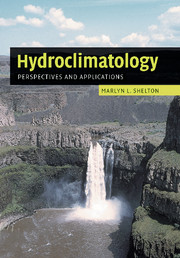Book contents
- Frontmatter
- Contents
- Preface
- 1 The realm of hydroclimatology
- 2 The climate system and the hydrologic cycle
- 3 Measuring hydroclimate atmospheric components
- 4 Measuring hydroclimate terrestrial components
- 5 Remote sensing and hydroclimate data
- 6 The runoff process and streamflow
- 7 Hydroclimate spatial variations
- 8 Hydroclimate temporal variations
- 9 Floods: the hydroclimatic extreme of excessive moisture
- 10 Drought: the hydroclimatic extreme of deficient moisture
- References
- Index
9 - Floods: the hydroclimatic extreme of excessive moisture
Published online by Cambridge University Press: 06 July 2010
- Frontmatter
- Contents
- Preface
- 1 The realm of hydroclimatology
- 2 The climate system and the hydrologic cycle
- 3 Measuring hydroclimate atmospheric components
- 4 Measuring hydroclimate terrestrial components
- 5 Remote sensing and hydroclimate data
- 6 The runoff process and streamflow
- 7 Hydroclimate spatial variations
- 8 Hydroclimate temporal variations
- 9 Floods: the hydroclimatic extreme of excessive moisture
- 10 Drought: the hydroclimatic extreme of deficient moisture
- References
- Index
Summary
Hydroclimatic extreme events
Floods and drought are recognized as extreme hydroclimatic events because they coincide with the tails of a streamflow frequency distribution, but they are recurrent hydroclimate features. These extreme hydroclimatic events are receiving increased attention as the loss of human life associated with these natural hazards grows and the costs related to these events soar exponentially (Easterling et al., 2000). In the last decade of the twentieth century, eight floods in different regions of the world caused more than 1000 fatalities each, and 24 floods resulted in total losses of one billion dollars each (Kundzewicz, 2002). These events have occurred against a backdrop of long-term climate variability and a perceived increase in variability related to climate change. In addition, rapid population growth and changes in land use and economic development in many parts of the world have placed greatly increased numbers of people at risk relative to extreme hydroclimatic events.
Floods and drought account for more damage annually in the United States than any other natural disaster, and there is an increasing trend in both flood damage and drought vulnerability (Lins and Slack, 1999). Concern for extreme events is heightened by an observed increase in atmospheric moisture since 1973 (Trenberth et al., 2003), an apparent increase in the proportion of total annual precipitation occurring as one-day extreme events (New et al., 2001), and a shift of precipitation to more extreme values (Wulfmeyer and Henning-Müller, 2006). While Robson et al.
- Type
- Chapter
- Information
- HydroclimatologyPerspectives and Applications, pp. 305 - 343Publisher: Cambridge University PressPrint publication year: 2008



